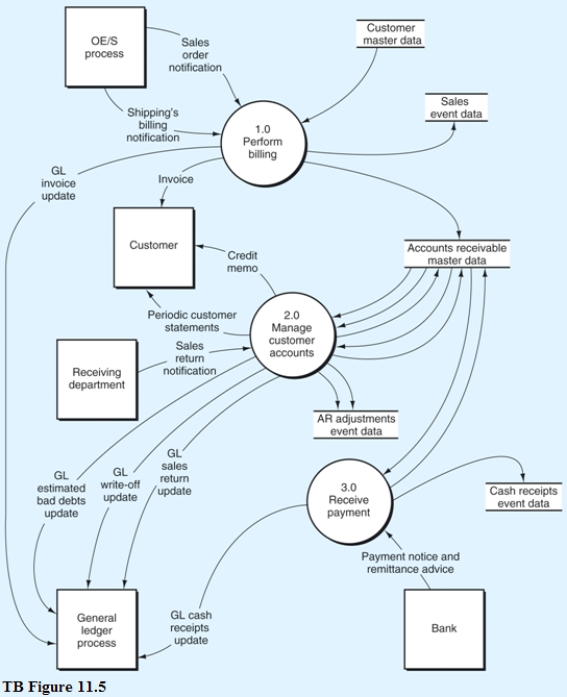Below is the narrative of the "Manage customer accounts" portion (i.e., bubble 2.0) of the B/AR/CR process.
Narrative Description
Processes 2.1 through 2.3 relate to sales returns adjustments. This process begins when there is notification from the receiving department that goods have been returned by a customer. Subprocess 2.1 obtains data from the accounts receivable master data to validate the return. If the sales return is not valid, it will be rejected (see Reject stub) and processed through a separate exception routine. If the sales return is valid, it is sent to subprocess 2.2 where a credit memo is prepared and sent to the customer, and the accounts receivable master data is updated to reflect the credit. At the same time, the validated sales return is sent to subprocess 2.3 where a journal voucher is prepared, which is used to create a record in the AR adjustments event data store (i.e., the journal), and the general ledger is notified that a credit memo has been issued. This results in updates to sales returns and allowances and to AR.
Process 2.4 is triggered by a periodic review of aging details obtained from the accounts receivable master data. The aging details would be used to identify and follow up on late-paying customer accounts. One of two types of adjustments might result from this review:
The recuring adgusting entry for estimated bad debts.
The periodic wite-off of "definitely warthess" customer accounts Like process 2.4, bubble 2.5, "Prepare customer statements," also is triggered by a periodic event that recurs at specified intervals, often on a monthly basis in practice. Details of unpaid invoices are extracted from the accounts receivable master data and are summarized in a statement of account that is mailed (or sent electronically) to customers.
Required:
Using the DFD in TB Figure 11.5 and the narrative description above, identify the words that belong in items 1 to 15 of Diagram 2.0 (TB Figure 11.6).


Definitions:
Medieval Doctors
Healthcare practitioners in the Middle Ages who often relied on a mixture of religious beliefs, superstition, and early medical practices to treat patients.
Penologists
Specialists in the study of penology, which focuses on the various aspects of the penal system, including the management of prisons and the rehabilitation of offenders.
Human-Environmental Factors
Refer to the interplay between human activities and the natural environment, including how human behavior impacts the environment and vice versa.
Lifestyle Factors
Refers to the behaviors and habits that influence an individual's health and well-being, including diet, physical activity, and smoking status.
Q50: Supply chain management software provides available to
Q53: Digital signatures address all of the following
Q65: With _ the data entry clerk compares
Q73: If a check of the customer master
Q78: _ is the application of computer and
Q82: A(n) _ and _ report is a
Q97: A retailer could misread a demand signal
Q104: Analytical applications, which include _, are intended
Q120: Which type of supply chain collaboration methods
Q128: In a balance-forward accounts receivable system, customer